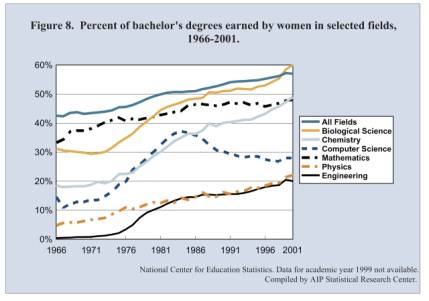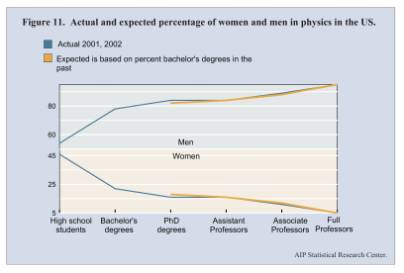|
Home
|
|||||||
The Coldest Science In a 1991 analysis of the underrepresentation of women in science and engineering, Stephen Brush called physics the “coldest science” (Brush, 1991). Despite more than a decade of progress, this is still largely true today. Figure 1 shows that the percentage of bachelor’s degrees in physics awarded to women has more than doubled, from about 10% to about 20%, in the last 25 years. But physics continues to lag behind mathematics and chemistry, where women now receive more than 40% of bachelor’s degrees (Ivie and Ray, 2005).
Figure 1. (taken from Ivie and Ray, 2005) Members of minority groups are also significantly underrepresented in physics. In 2001, only 17% of physics bachelor’s degrees were awarded to members of minority groups (NSF, 2004, table C-9). In that same year, 44 African American women and 33 Hispanic American women received bachelor’s degrees in physics (Ivie and Ray, 2005), out of 756 women and 3457 total physics bachelor’s degrees (NSF, 2004, table C-5).
Figure 2. (Taken from Ivie and Ray, 2005) The reasons for this are many, ranging from the white-male-dominated culture of physics to career-family conflicts that limit career options for women scientists. Ivie and Ray (2005) have identified the undergraduate years as the most important “leak point” for women in the “pipeline” leading to a career in physics, as shown in Figure 2. So an important component of increasing the number of women and members of minority groups in physics involves attracting and retaining a broader range of students to the undergraduate physics major. What Can We Do to Make Physics More Female-Friendly? In 2003, Yu Xie and Kimberlee Shauman studied the careers of women scientists, beginning with high school. They found that young men are three times more likely than young women to aspire to major in science as high school seniors. This gap in aspiration is not explained by any difference in achievement in science or mathematics. Elaine Seymour and Nancy Hewitt (1997) published a major study of the reasons why students chose to abandon or persist in an undergraduate major in science, mathematics, or engineering (SME). In their study of gender differences, they conclude that the large lecture-oriented class and impersonal style of many introductory SME courses seem hostile to many young women, leading them to switch to majors they find more welcoming. Pre-college socialization predisposes young women to prefer cooperative learning to competitive situations. Young women have less experience with laboratory equipment, and are more likely to have doubts about their ability (independent of their actual ability.) All these factors make it likely that young women are more negatively affected by the “weedout” system prevalent in many introductory courses in physics. Working difficult but meaningless problems can seem like “hazing” to young women—Seymour and Hewitt quote one young woman as saying “it seems like the teachers make it harder than it needs to be.” This is not necessarily deliberate on the part of faculty. Nevertheless, in a male-dominated community like physics, teachers’ desire to treat everyone the same often means treating everyone like men, which can disadvantage young women. In Female Friendly Science, Sue Rosser (1990) studied the research methods of women scientists, and suggested ways that we might revise science courses to be more compatible with these methods. There is some common ground with Seymour and Hewitt; Rosser looks for cooperation rather than competition, and suggests that we emphasize the social and environmental applications of physics, while downplaying military applications. In addition, Rosser suggests using more holistic and interdisciplinary problems rather than narrowly defined “puzzle” problems. She encourages us to look at science from the point of view of women and other historically underrepresented groups. The physics community is concerned about the underrepresentation of women and minorities, and has devoted considerable attention to reforming the curriculum and culture of undergraduate physics. See, for example, Abraham, et al., 1991; di Stefano, 1996a, 1996b; Project Kaleidoscope, 1991; Hilborn, et al., 2003; Whitten, et al., 2003, 2004. Much of the attention of the physics community has focused on the introductory course, and a number of changes in the curriculum and pedagogy have been implemented. See, for example, Laws, 2004; McDermott, 1996; di Stefano, 1996a, 1996b; Moore, 2002. Some of these projects involve changing or rearranging the topics of the introductory physics course. Many also modify or abandon the traditional lecture-recitation-lab course and rely on workshops, peer learning groups, and other active learning techniques. The Physics Education Group at the University of Minnesota, headed by Eric and Patricia Heller (http://groups.physics.umn.edu/physed/index.html), have studied the use of cooperative learning groups in introductory physics, and developed what they call context-rich problems. These problems provide a story, often in the second person, out of which the problem grows naturally. |
|||||||
Posted on 8/1/05 © 2000-2005 Physics For Everyone. All Rights Reserved. |
|||||||

